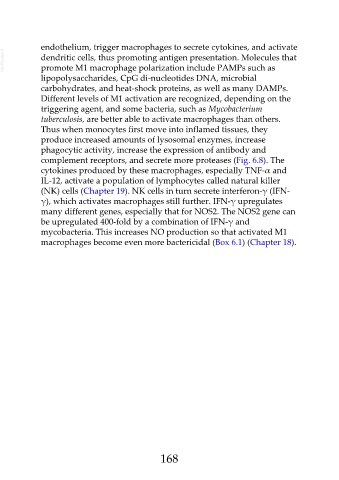Page 168 - Veterinary Immunology, 10th Edition
P. 168
endothelium, trigger macrophages to secrete cytokines, and activate
VetBooks.ir dendritic cells, thus promoting antigen presentation. Molecules that
promote M1 macrophage polarization include PAMPs such as
lipopolysaccharides, CpG di-nucleotides DNA, microbial
carbohydrates, and heat-shock proteins, as well as many DAMPs.
Different levels of M1 activation are recognized, depending on the
triggering agent, and some bacteria, such as Mycobacterium
tuberculosis, are better able to activate macrophages than others.
Thus when monocytes first move into inflamed tissues, they
produce increased amounts of lysosomal enzymes, increase
phagocytic activity, increase the expression of antibody and
complement receptors, and secrete more proteases (Fig. 6.8). The
cytokines produced by these macrophages, especially TNF-α and
IL-12, activate a population of lymphocytes called natural killer
(NK) cells (Chapter 19). NK cells in turn secrete interferon-γ (IFN-
γ), which activates macrophages still further. IFN-γ upregulates
many different genes, especially that for NOS2. The NOS2 gene can
be upregulated 400-fold by a combination of IFN-γ and
mycobacteria. This increases NO production so that activated M1
macrophages become even more bactericidal (Box 6.1) (Chapter 18).
168

